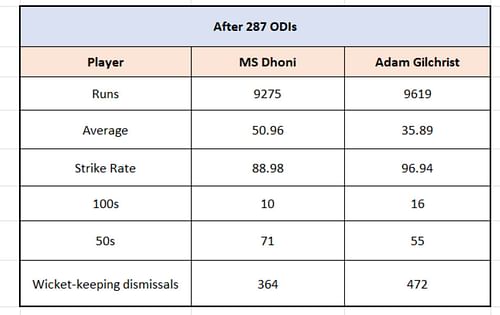
MS Dhoni vs Adam Gilchrist - comparing the stats of the two wicket-keepers after 287 ODIs
Wicket-keeping legends MS Dhoni and Adam Gilchrist dominated the sport with the willow and gloves as very few have. While the duo were magnificent all-format cricketers, they were revered by the opposition for their match-winning abilities in white-ball cricket.
Gilchrist finished his illustrious Australian career with 287 ODIs and in many ways revolutionized the role of a wicket-keeper. Cricket can be divided into a pre-Gilchrist and post-Gilchrist era, with the former asking wicket-keepers to only be specialists and the latter forcing glovemen to also flourish with the bat.
As for Dhoni, his 350 ODI games changed the Indian public from being a largely numbers-driven nation to one that valued winning more. Despite not boasting of many important quantitative records, Dhoni garnered fandom as very few cricketers have in history, thanks to his inimitable ability to come up clutch and finish games.
Comparing the two on numbers alone is a tad bit unfair to both, considering Gilchrist opened the batting for most of his ODI career and Dhoni batted in the lower middle-order just as much.
Hence, let us take a look at those and other contextualized numbers of the two wicket-keeping legends after 287 ODIs (Gilchrist’s overall ODI appearances) of their respective careers.
Counting numbers in front of and behind the stumps
Let us start with the wicket-keeping aspect of Dhoni and Gilchrist after 287 ODIs. While the Australian finished with an incredible 472 dismissals, Dhoni was on 364 dismissals after his 287 ODI outings.
Coming to the batting, Gilchrist scored 9,619 runs in his 287-match ODI career, while Dhoni was on 9,275 runs at the same point. However, the former Indian wicket-keeper makes up for the deficit in the number of runs with his remarkable batting average of 50.96, compared to Gilchrist's 35.89.

Both legends boasted excellent strike rates but Gilchrist's 96.94 trumps Dhoni's 88.98 in 287 ODIs each. The century and half-century milestones were a product of their batting positions, with Gilchrist amassing 16 tons and 55 fifties, while Dhoni stood on 10 centuries and 71 half-centuries in 287 ODIs.
Impact numbers and ICC tournament performances
Much of ODI cricket isn't about total numbers but about how impactful a cricketer's performance is in team wins and big matches. To analyze that between Dhoni and Gilchrist, let us look at their numbers in wins and how they stacked up in ICC events.
While both wicket-keeper batters produced magical performances in winning causes, the Indian legend emphatically wins this contest. Gilchrist averaged an excellent 41.16 at a strike rate of 99.33 in 202 Australian wins in 287 ODIs.
Meanwhile, Dhoni ensured his best often led to victories for India, averaging a remarkable 72.02 at a strike rate of 98.03 in 159 ODI wins out of 287 total matches.
Coming to ICC tournaments and other big matches, we consider the World Cup, Champions Trophy and tournament finals to see how Dhoni and Gilchrist fared in them. The Aussie legend wasn't always at his absolute best in the Champions Trophy, evidenced by his average of 31.83 at a strike rate of 94.08 in 13 outings.

Yet, Dhoni was even worse in Champions Trophy encounters, averaging a dismal 19.33 at a strike rate of 77.85 in 12 games.
The World Cups, however, was a different story for both these wicket-keeping stalwarts. While Gilchrist averaged an excellent 36.16 at a strike rate of 98.01 in 31 World Cup matches, Dhoni averaged 42.25 at a strike rate of 91.18 in 20 World Cup clashes until his 287th overall ODI.
Much like the World Cup, both cricketers shone brightly in the final of tournaments. Gilchrist averaged 37.51 at a strike rate of 102.64 in 33 finals, while Dhoni averaged 49.30 at a strike rate of 85.73 in 13 finals.
Conditions and opposition-based numbers
The other key aspect when it comes to analyzing numbers is performances at home and away conditions, along with performances against the best teams. For the sake of this exercise, we consider India/Australia, England, South Africa, Pakistan, Sri Lanka and New Zealand as the opposition teams that were usually strong during Dhoni and Gilchrist's careers.

While the specifics when it comes to strike-rates are similar and only slightly in favor of Gilchrist, it is crystal clear from the above table that Dhoni has a massive edge in home and away averages. The former Indian captain also boasts a batter average than Gilchrist against each of the strong opposition sides except in India-Australia battles.
Conclusion
In conclusion, one must remember the vastly different roles Gilchrist and Dhoni played for their respective sides in ODIs. While the Aussie had to set the tone at the top with his attacking stroke play from ball one, Dhoni had to assess situations and bail India out of trouble or finish matches off in the lower middle-order.
Nevertheless, should a comparison be made on the numbers, Dhoni's consistency was substantially higher than Gilchrist's, even if the latter enjoyed a slightly better strike rate across parameters.